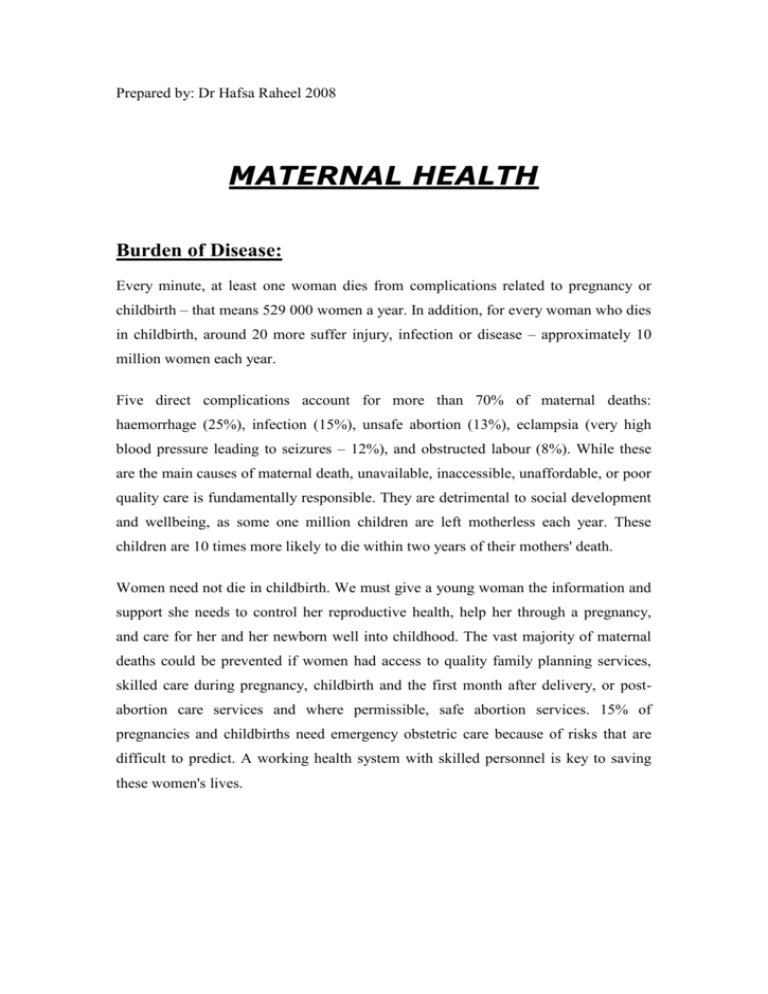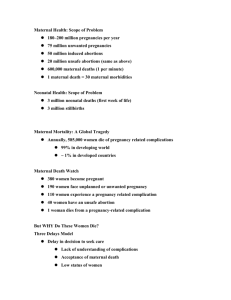MATERNAL HEALTH
advertisement

Prepared by: Dr Hafsa Raheel 2008 MATERNAL HEALTH Burden of Disease: Every minute, at least one woman dies from complications related to pregnancy or childbirth – that means 529 000 women a year. In addition, for every woman who dies in childbirth, around 20 more suffer injury, infection or disease – approximately 10 million women each year. Five direct complications account for more than 70% of maternal deaths: haemorrhage (25%), infection (15%), unsafe abortion (13%), eclampsia (very high blood pressure leading to seizures – 12%), and obstructed labour (8%). While these are the main causes of maternal death, unavailable, inaccessible, unaffordable, or poor quality care is fundamentally responsible. They are detrimental to social development and wellbeing, as some one million children are left motherless each year. These children are 10 times more likely to die within two years of their mothers' death. Women need not die in childbirth. We must give a young woman the information and support she needs to control her reproductive health, help her through a pregnancy, and care for her and her newborn well into childhood. The vast majority of maternal deaths could be prevented if women had access to quality family planning services, skilled care during pregnancy, childbirth and the first month after delivery, or postabortion care services and where permissible, safe abortion services. 15% of pregnancies and childbirths need emergency obstetric care because of risks that are difficult to predict. A working health system with skilled personnel is key to saving these women's lives. Definition: Maternal and Child health (MCH) “Maternal and Child health (MCH) refers to the promotive, preventive, curative, and rehabilative health care for mothers and children. It includes the sub areas of maternal health, child health, family planning, school health, handicapped children, adolescence, and health aspects of care of children in special settings such as day care.” Specific Objectives of MCH Reduction of maternal, perinatal, infant and childhood mortality and morbidity Promotion of Reproductive health Promotion of the physical and psychological development of the child and adolescent within the family Components of MCH Maternal health Family planning Child health School health Handicapped children Care of children in special setting such as Day care Phases of Maternal Health A womens health is effeted by various factors operating throughout her life. These include biological, social cultural, indivisual behavioural and life style as well as the status of the health services. The foundation of health is laid during childhood and adolescence and many of the health problems of reproductive age may find their beginning from that phase. Eg:poor diet or inadequate health care in that phase will cause stunting of growth, anemia and ill health which may effect her future child bearing with a higher risk of complications. The difference phases of life and related problems of a female can be divided as under: A) Before Pregnancy: Nutrition of mother can effect - fetal growth - birth weight - nutrition of child during infancy Infections Maternal Abs – passive immunity Maternal immunizations – protects against adverse outcomes B) During pregnancy Nutrition o fmother is very important for mother and child with regard to weight, and anemia Care of the breast – prevention of cracks and sour nipples Infections Rubella Syphilis Malaria UTI Tetanus immunization Smoking Heavy work and stress Psychological stress C) Labour and post partum Infections – Opthalmia neonatorum, tetanus neonatorum Bleeding Trauma Asphyxia Lactation problems, insufficient breast mild Birth spacing – family planning Indicators for Maternal Health Maternal Death Death of a women while pregnant or within 42 days of termination of pregnancy, irrespective of the duration and the site of pregnancy, from any cause related to or aggravated by pregnancy or its management but not from accidental or incidental cause. Maternal mortality Ratio (MMR) Annual number of deaths of women from pregnancy-related causes per 100,000 live births. It measures the risk of women dying once pregnant Interventions for Maternal Care Proven and effective interventions for reducing maternal and newborn disability and death • Social support should be available for women during labour and birth. • Breastfeeding should start within one hour after birth. • Every newborn should have a safe and clean birth and be immediately dried and kept warm to protect against hypothermia; the umbilical cord should be cut using a safe technique, and should be kept clean and dry. • The WHO antenatal care package should be used for all pregnant women. • Magnesium sulfate should be used to treat severe pre-eclampsia and eclampsia. • A partogram should be used to identify obstructed labour. • Oxytocin should be used for all women as part of the active management of the third stage of labour. • Antibiotic prophylaxis should be used forwomen undergoing caesarean delivery. • Manual vacuum aspiration (MVA) should be used for management of incomplete abortion and induced abortion. • Kangaroo-mother-care should be used for all low birth weight babies. • Assisted delivery (including caesarean section) should be performed in cases of obstructed labour. • Iron and folate supplements should be given routinely during pregnancy to prevent maternal anaemia. WHO strategy for Safe Motherhood: For making motherhood safe, WHO has recommended four strategic interventions or "four pillers" which should be delivered through the primary health care on the foundation of equity for women. They are Family planning: to ensure that indivisuals and couples have the information and services to plan th etiming, number and spacing of pregnancies. Antenatal care: To prevent complications where possible and ensure that complications when present are detected early and treated appropriately. Clean / Safe delivery: To ensure that all birth attendants have the knowledge, skill and the equipment to perform a clean and safe delivery and provide postpartum care to mother and baby. Essential obstetric care: To ensure that essential care for high risk pregnancies and complications is made available to all women who need it. SAFE MOTHERHOOD SD F P ANC EOC BASIC MATERNITY CARE PRIMARY HEALTH CARE EQUITY FOR WOMEN FP: Family planning, ANC: Antenatal care, SD : Clean safe delivery, EOC:Emergency obstetrics care








